One of the biggest concerns with electric cars is the lifespan of batteries and how quickly they degrade over time due to high mileage and repeat recharges.
But a team of professional vehicle testers has revealed the true impact of heavy use on the condition of EV batteries – and it’s not all that dramatic.
ADAC, Germany’s equivalent to the AA, and its team of vehicle accessors have been extensively using an electric Volkswagen ID.3 for the last four years.
In that time, it has clocked 107,000 miles. As such, it has now exceeded the 77kWh high-voltage battery’s 100,000-mile warranty.
Analysing the battery’s health and found it has declined 9 per cent – an average of 2.25 per cent annually.
This has translated to a loss of just eight miles for its measured full-charge range.
Now find out how much it has cost to service, fix and run in general…
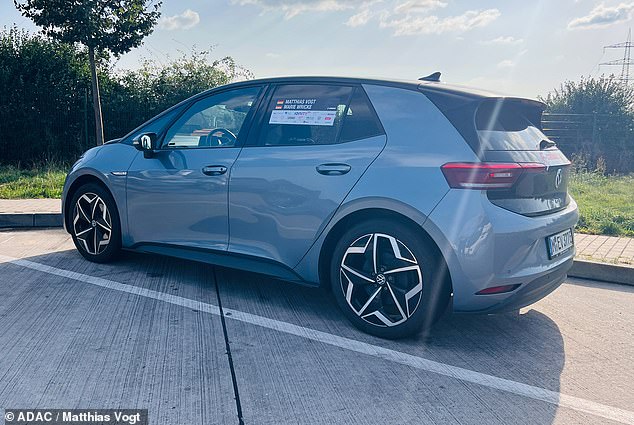
ADAC, Germany’s equivalent to the AA in the UK, has driven an electric VW ID.3 for 107,000 miles in the last 4 years. Over that period, it has lost 9% of its battery capacity, it said
Due to the relative infancy of EVs, for the meantime it is difficult to truly measure the lifecycle of their batteries.
While testers can accelerate the impact of mileage and charging by repeatedly running them in artificial scenarios in laboratory conditions, this is not a robust reflection of typical driving behaviour – and doesn’t play to the advantages of batteries, which do not perform optimally when subjected to extended periods of consistent use.
Therefore, ADAC’s latest ‘endurance test’ results using a Volkswagen ID.3 with the 77kWh battery (costing from £39,000 in the UK, which is marginally over the threshold for Labour’s new Electric Car Grant) can be considered an accurate depiction of what drivers should expect from EV battery performance and longevity as these cars get older and driven over longer distances.
The same car it originally tested in 2021 was retained by the team of testers and driven by various employees over the last four years through all seasons.
The VW has been regularly recharged up to 100 per cent and left at that level for several days while being shared by its team of engineers, it explained.
The company says most recharges have been completed using a rapid charger at its testing headquarters, meaning the battery was fast charged much more often than would be the case for a typical EV owner.
Studies have shown that UK drivers of electric cars are most likely to recharge using a slower 7kW wallbox at their home overnight using their domestic energy tariff.
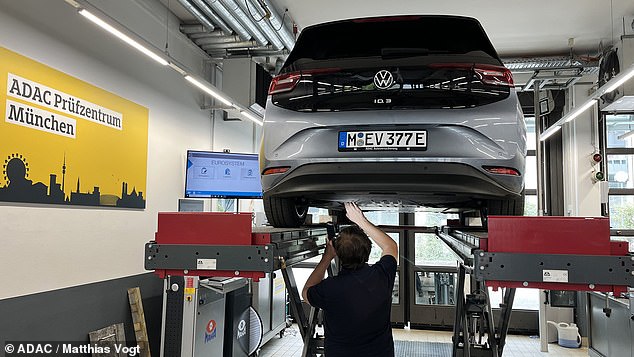
ADAC originally tested the range of the all-electric VW hatchback in 2021 when it was almost brand new. Some 48 months and 107k miles later, it was measured again and showed a loss of only 8 miles
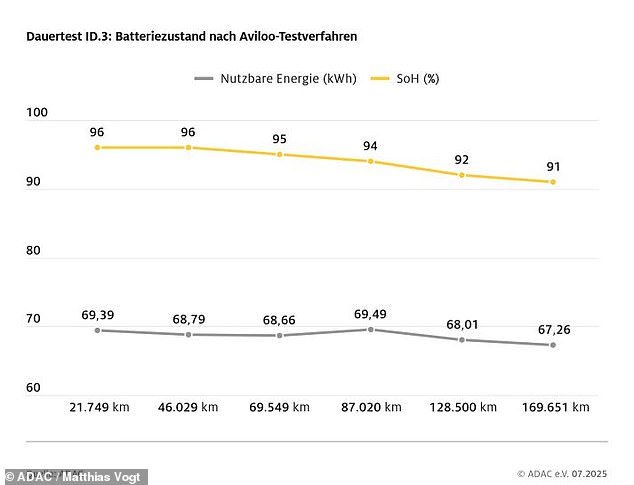
This chart tracks the usable energy in the battery (grey line) and its state of health (yellow line) over the last four years, in which it has covered 107,000 miles. A software update at around 87,000km saw the usable energy of the battery increase
ADAC’s report at 107k miles says that software updates over the car’s life have gradually improved its energy efficiency, which has offset some of the losses from the battery.
When it lab tested the ID.3 in 2021, it was measured at covering 3.11 miles per kWh.
Having retested the same vehicle after surpassing the battery’s warranty, it is now doing 3.40 miles per kWh.
The team has also calculated the real-world performance outside lab conditions, with the EV achieving an average of 2.70 miles per kWh over 107,000 miles.
Over the air software updates provided by Volkswagen since 2021 have also improved the battery’s charging speed as well as range efficiency.
Four years earlier, ADAC said the ID.3 was measured drawing a maximum of 125kW when charging. However, since the software upgrades, it can now achieve charging speeds of 160kW.
This translated to a two-minute time saving when charging from 10 to 80 per cent, it said.
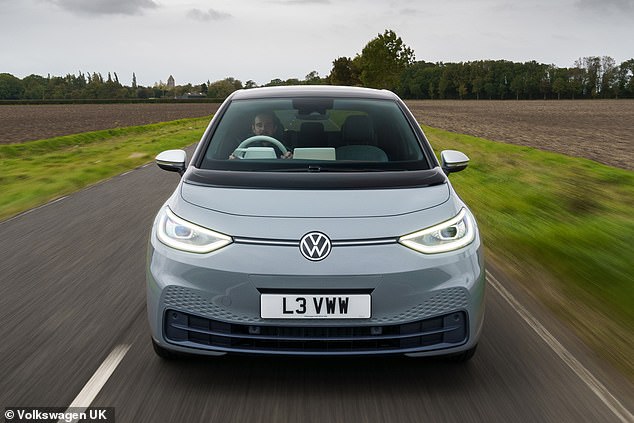
ADAC said it typically used a rapid charger to fast charge the electric VW. However, in Britain, most electric car drivers plug their vehicles into a slower 7kW domestic wallbox at home
Tests of the battery’s sate of health was also consistently monitored.
Between 13,500 and 43,200 miles, ADAC said it was showing a sustained health level of 96 per cent, dropping by 1 per cent when it reached the latter distance.
It fell again to 95 per cent at 52,400 miles, slipping to 93 per cent at 64,000 and 92 per cent by 80,000 miles.
Between 90,600 and 107,000 miles, it has a battery health reading of 91 per cent.
This puts the battery condition well above the battery warranty’s minimum level, which is 70 per cent after 100k or 10 years, whichever comes first.
Its team of technicians said more recent VW models should perform even better than the ID.3.
This is because newer EVs from the German car giant have battery heaters that can be activated remotely by drivers, meaning they will require shorter charging breaks during colder temperatures.
Last year, a separate study of 5,000 ‘real-life’ modern EVs concluded that batteries are showing slower signs of degradation than engine components used in petrol and diesel cars.
Geotab – a leading firm in fleet and business telematics – carried out analysis of the battery health of fleet and private EVs, using 1.5 million days of telematics data to explore how the latest battery technology holds up to the rigours of daily use.
The data suggested that EV batteries in current models degrade, on average, by 1.8 per cent annually.
When it conducted the same study back in 2019, it found that the efficiency of batteries was declining at a rate of 2.3 per cent per year on average, suggesting advances have been made in the last five years to extend the lifespan of the technology.
The report went on to say that EV batteries now ‘generally degrade more slowly than internal combustion engine drivetrain components’.

ADAC drove and charged the VW ID.3 through all seasons over the last 4 years. The battery has now surpassed its warranty mileage, though is proving reliable. But the car itself has suffered a few hiccups over the last 48 months…
Not all plain sailing…
While the battery performance of the electric Volkswagen impressed, ADAC said the four-year spell with the car hasn’t been entirely faultless.
It reported an issue with the GPS antenna, which also rendered the eCall system [which automatically calls VW’s emergency line if the car is involved in a crash] unavailable. The cost to put this right was €525 (£455).
And at 98,000 miles the ID.3 ‘briefly broke down’ due to a fault with the automatic door opening system prevented it from starting.
‘This problem could only be resolved with a software update,’ the German testers said.
A defect in the charging flap also had to be repaired at the workshop for €227 (£197).
That said, ADAC claims the running costs for the Golf-sized electric VW have been ‘pleasingly’ low.
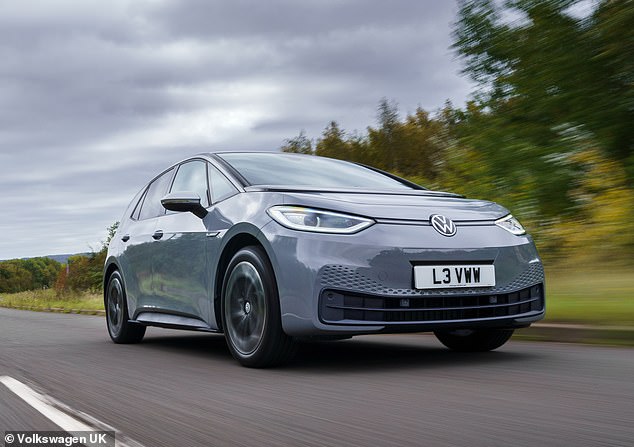
Servicing costs are incredibly low. This is because all VW electric ‘ID’ models have two-year service intervals, irrespective of the mileage. This is due to the fewer moving mechanical parts
Despite covering more than 100,000 miles, it has undergone just two scheduled services costing a total of €427 (£370), of which almost half was to re-gas the air conditioning system.
All Volkswagen electric ID models have two-year service intervals, irrespective of the mileage. This is due to the fewer moving mechanical parts.
ADAC will continue to measure the performance of the electric hatchback.
It said it will be testing the battery health and measuring the maximum available range again at 250,000km (155k miles).
‘The endurance test is far from over and will continue to monitor the battery after the warranty expires and to document any unforeseen repairs,’ it said in an official statement.












